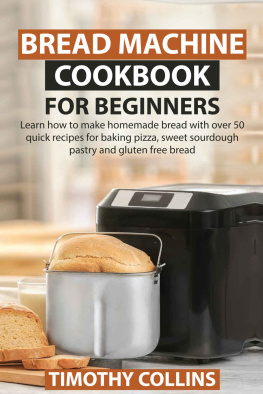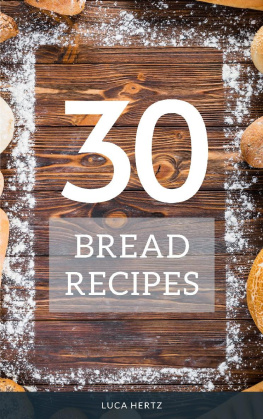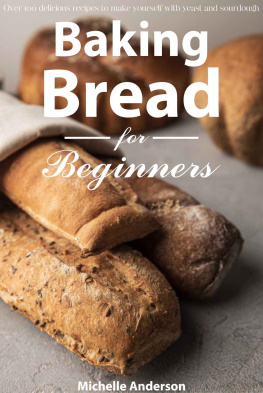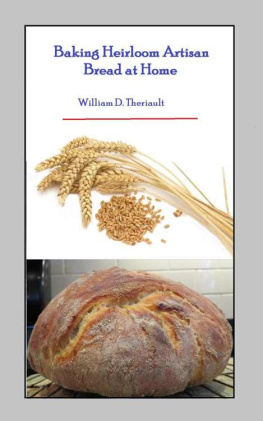Table of Contents
The Bread Baking Book for Beginners
Including bread baking with yeast and sourdough, protein bread, low carb, gluten-free and much more
Author: Kevin Thomas
Table of Contents
Preface
Baking bread yourself is becoming increasingly popular. Because it is a pleasure for all the senses and healthy too. And best of all: Baking bread is very easy!
So far, have you asked yourself whether it is worth the effort or if you shy away from baking bread yourself because of complicated bread recipes and dirt in the kitchen? This is over now: Baking bread in Stone Ware molds is the solution! Because the effort is minimal, but the results are all the more delicious.
Often, complicated steps such as long dough kneading and bread shaping by hand are completely eliminated. At the same time, the bread stays in perfect shape and is extremely juicy. A wonderful crust and an intense aroma round off bread baked in Stone Ware perfectly.
So there are many advantages that speak in favor of this great and particularly simple, clever way of baking bread.
What are you waiting for? Try these quick and easy bread ideas right away and pamper yourself and your loved ones with a very special treat and the good feeling of eating consciously and healthily!
Stone Ware: Things to Know and Tips
What is Stone Ware?
Stone ware, also known as earthenware, is a natural product made from clay. A certain white clay is very often used here, but other types of clay are also used - depending on the manufacturer - for the production of stoneware. The clay is brought into the desired shape, for example as a baking pan or pot. The natural material used has some advantages over, for example, stainless steel or plastic forms. On the one hand, it is a sustainable, natural product and less energy is used in its production than is necessary, for example, to manufacture metal pots and molds. Stone ware molds are hygienic, food-safe and there is no risk of microorganisms settling in earthenware molds or that they take on foreign smells or a strange taste.
Stone Ware can also do something very special when baking bread: It can create a baking climate that otherwise only occurs in professional stone ovens, such as those still used today in traditional bakeries to bake artisanal bread. The stone oven ensures an optimal baking process, in which a crispy crust and a juicy crumb are formed. In addition, the flavors of the bread come into their own. The same works in Stone Ware molds.
That is why they are finding more and more fans in the modern kitchen. And this, although it is by no means a new invention, but rather baking and cooking utensils with a long history:
Between tradition and modernity: Stone Ware through the ages
Stone ware pots and molds are experiencing a real boom in modern kitchens. Yet they are not a new invention.
Stone ware forms and pots are usually a pot or vessel made of clay, which is often supplemented with a lid made of the same material. In it, food is prepared in the oven, for example - in earlier times this was done over the embers or ashes of a fire. This method of cooking food in clay vessels (with or without a lid) has been handed down from Roman times. And in other regions of the world, such as the Balkans, North Africa and even Japan, this type of food preparation has been widespread for centuries. It can therefore be assumed that the technique of preparing food in clay pots and vessels similar to clay pots was known and widespread long before the time of the Romans.
Cooking and baking in Stone Ware in general
Dishes are cooked gently in Stone Ware pots and in their own juice, which means that taste and consistency are preserved and vitamins are conserved. But the clay pot can do even more. It is also ideal as a baking pan. Due to its special properties and shape, it is perfect for bread. The fine pores of the clay ensure a nice, crispy, but at the same time tender crust. Bread that is baked in Stone Ware cooks evenly, it does not collapse because of the good heat storage and it turns out high and loosely. And: Stone Ware pots are also suitable as bread boxes for storing bread. Bread stays fresh longer in the earthenware pot - closed with the supplied lid - without going moldy.
Baking bread in stone ware molds
For the recipes presented here, we recommend either a Stone Ware pot with a capacity of approx. 2.5 to 3 liters for larger loaves of bread or a smaller pot or a box shape with a capacity of approx. 1.4 liters for smaller loaves of bread.
In case of doubt, the following applies: A larger pot does not do any harm either, it just makes your bread a little flatter.
If you are planning a new purchase, we recommend a pot or a shape with a capacity of at least 3 liters with a lid. With such a model you are well equipped in any case and can conjure up versatile dishes in the kitchen that go far beyond baking bread.
Stone Ware is suitable for ovens with top and bottom heat, convection and even microwave ovens. She doesn't mind a temperature of up to 230 C. However, do not place them directly under the grill or on a heat source. You should always keep a distance of approx. 13-15 cm to the heat source (e.g. to the heating coil in the oven). We recommend that you always fill Stone Ware pots and pans with the food - in our case the bread dough - and then put them in the cold oven and heat them up together with the oven. So do not preheat the oven. Incidentally, this also benefits the yeast or the sourdough in bread.
There are now molds and pots made of Stone Ware that are much more robust and that in principle do not mind being heated to high temperatures when empty. But our experience shows that bread in earthenware molds still works best when they are put into the cold oven and heated up together with the mold. This also protects the material.
Grease your Stone Ware pot before filling it with the bread dough for the first time. The first few times you should always grease the pan so that the bread does not stick. Later, when the shape has developed its typical patina, this is no longer absolutely necessary. However, we still recommend greasing your earthenware mold before baking bread, because this ensures that the bread actually slides out of the mold after baking, and you also get a particularly delicious crust. If you like, you can also sprinkle the shape with oat or spelled flakes, seeds, grains or chopped nuts. This creates a particularly tasty crust and the bread slides out of the mold by itself after baking.
Cleaning and care
You should of course thoroughly clean new molds before using them for the first time. We recommend that you always wash earthenware molds and pots by hand. Do not use any cleaning agents, only warm water and - if necessary - a cleaning spatula or dish brush to remove baked-on food. For stubborn dirt, we recommend soaking the mold for a while: Simply pour warm water into it and let the mold stand for a while. Most of the dirt can then be easily removed. Then dry the form thoroughly and let it air dry completely.
Over time and with use, a natural non-stick layer forms, which makes the stoneware darker over time. To encourage the formation of this desired patina, grease the pan several times before baking, e.g. with cooking oil. However, please do not use a non-stick spray, as this will leave residues that are difficult to clean.
If a particularly thorough cleaning is required, we recommend using a mixture of baking soda and water. Soda is able to loosen even stubborn dirt. Simply mix 130 g of baking soda with 45 - 50 ml of water to form a viscous mass. Now apply this to the dirt. After about 5 minutes, wipe off a little of the paste to see if it has already removed the stains, otherwise leave it on and check every 5 minutes. After 20 minutes at the latest, all dirt should be removed and you can now rinse your mold or pot with clear water and dry it off.






